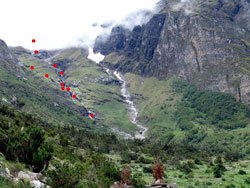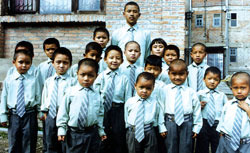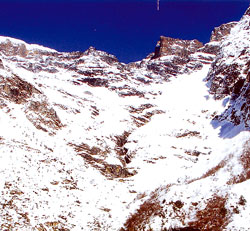|
|
| The gorge into which the climbers were swept into by the avalanche last October and last week after the snow had melted |
All Dawa Lama remembers is a loud boom and immediately after that a terrific whoosh.
When he regained consciousness, he was lying 30 metres away from camp. In the darkness, Dawa located three other porters from his tent. They looked for the others but couldn't find them and plodded down to Meta village in their bare feet.
On 20 October 2005 at the French expedition to 6,800m Kang Guru had pulled back from advanced base camp because of heavy snowfall and returned to lower base camp at 4,200m. It was 5PM and the team had just gone into their tents after tea when the avalanche struck. Dawa Lama and three porters survived, seven French climbers and 11 Nepalis were killed. Nine of the dead were from the village of Larpak in Gorkha.
 |
| The places where the bodies were found are marked with red dots. |
A rescue mission was mounted soon after the tragedy but only three of the bodies were found. The rest had been swept by the blast wave into a 400m long-gorge that comes off the mountain. There was nothing to do but wait for the snow to melt.
Last week, our rescue team that included five French members returned to the scene. It was a different world, the snow had been replaced by lush green meadows full of flowers and monsoon clouds shrouded the peaks. The snow in the gorge had melted and the team immediately located six of the bodies amidst the boulders. Another body was found below a 50m waterfall. Three climbers took all day rappelling down to get it out.
 |
| The children of the dead Nepali porters at a school in Balaju. |
The French team was led by 56-year-old Daniel Stolzenberg, an experienced mountaineer and a recently retired teacher at the l'Ecole Nationale de Ski et d'Alpinisme in Chamonix, France. The head of the Nepali team, Iman Singh Gurung, was an experienced climber and was expirenced climber and was president of the National Guide Association
 |
| A body is retrieved from a 50m deep ravine below base camp. |
This is one of the first times that an expedition has returned to the scene of a mountaineering tragedy in Nepal to clean up, and the trend should be encouraged.
What made retrieval possible was that the base camp was relatively low on the mountain and the bodies were exposed after the snows melted. Not all accident sites are as accessible and a clean up operation can be almost as costly as the expedition itself.
But where possible it should be done not just for the memory and dignity of those who died, but also to preserve the sanctity of the mountains that they wanted to climb.



